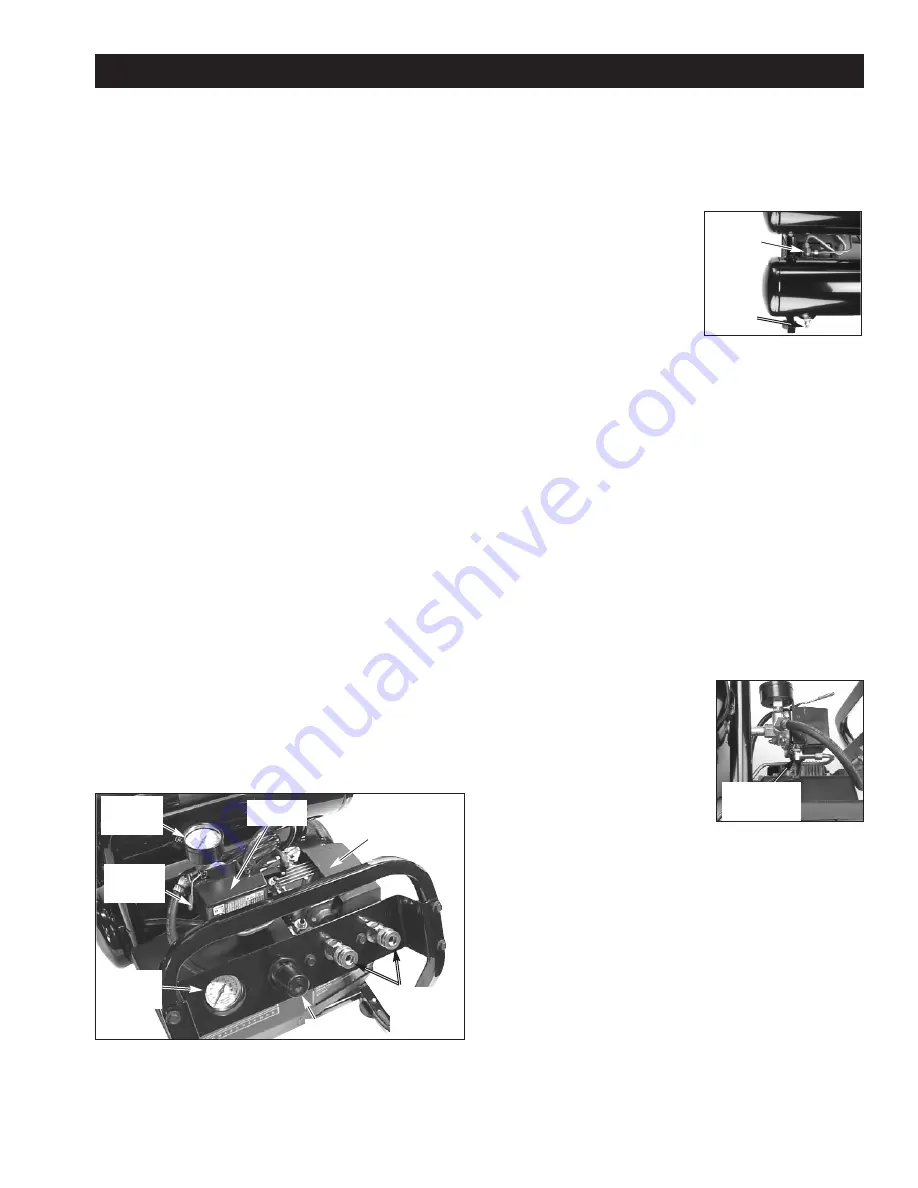
9 - ENG
D24072
OPERATION
Description of Operation
Become familiar with these controls before operating
the unit.
On/Auto/Off Switch
: Turn this switch ON to provide
automatic power to the pressure switch and OFF to
remove power at the end of each use.
Pressure Switch:
The pressure switch automatically
starts the motor when the air tank pressure drops
below the factory set “cut-in” pressure. It stops the
motor when the air tank pressure reaches the factory
set “cut-out” pressure.
Safety Valve (not shown):
If the pressure switch does
not shut off the air compressor at its “cut-out”
pressure setting, the safety valve will protect against
high pressure by “popping out” at its factory set
pressure (slightly higher than the pressure switch
“cut-out” setting).
Outlet Pressure Gauge:
The outlet pressure gauge
indicates the air pressure available at the outlet side
of the regulator. This pressure is controlled by the
regulator and is always less than or equal to the tank
pressure.
Tank Pressure Gauge:
The tank pressure gauge
indicates the reserve air pressure in the tank.
Regulator:
Controls the air pressure shown on the
outlet pressure gauge. Pull the knob out and turn
clockwise to increase pressure and counterclockwise
to decrease pressure. When the desired pressure is
reached push knob in to lock in place.
Drain Valve:
The drain valve
is located at the base of the
air tank and is used to drain
condensation at the end of
each use.
Cooling System (not shown)
:
This compressor contains an
advanced design cooling system. At the heart of this
cooling system is an engineered fan. It is perfectly
normal for this fan to blow air through the vent holes
in large amounts. You know that the cooling system is
working when air is being expelled.
Air Compressor Pump:
Compresses air into the air
tank. Working air is not available until the compressor
has raised the air tank pressure above that required at
the air outlet.
Check Valve:
When the air compressor is operating,
the check valve is “open”, allowing compressed air to
enter the air tank. When the air compressor reaches
“cut-out” pressure, the check valve “closes”, allowing
air pressure to remain inside the air tank.
Pressure Release Valve:
The pressure release valve
located on the side of the pressure switch, is
designed to automatically release compressed air
from the compressor head and the outlet tube when
the air compressor reaches
“cut-out” pressure or is shut off.
The pressure release valve
allows the motor to restart
freely. When the motor stops
running, air will be heard
escaping from this valve for a
few seconds. No air should be
heard leaking when the motor is running, or
continuous leaking after unit reaches “cut-out”
pressure.
Universal Quick-Connect Body:
The universal
quick-connect body accepts the three most popular
styles of quick-connect plugs- Industial, automotive
(Tru-flate), and ARO. One hand push-to-connect
operation makes connections simple and easy. The
two quick-connect bodies allow the use of two tools
at the same time.
Know Your Air Compressor
READ THIS OWNER’S MANUAL AND SAFETY RULES BEFORE OPERATING YOUR UNIT. Compare the
illustrations with your unit to familiarize yourself with the location of various controls and adjustments. Save this
manual for future reference.
Drain
Valve
Pressure
Switch
Tank
Pressure
Gauge
On/Auto/
Off
Switch
Outlet
Pressure
Gauge
Regulator
Universal
Quick
Connect
Bodies
Air
Compressor
Pump
Check
Valve
Pressure
Release
Valve
Summary of Contents for 919.167460
Page 34: ...34 SP D24072 ...
Page 35: ...35 SP D24072 ...










































